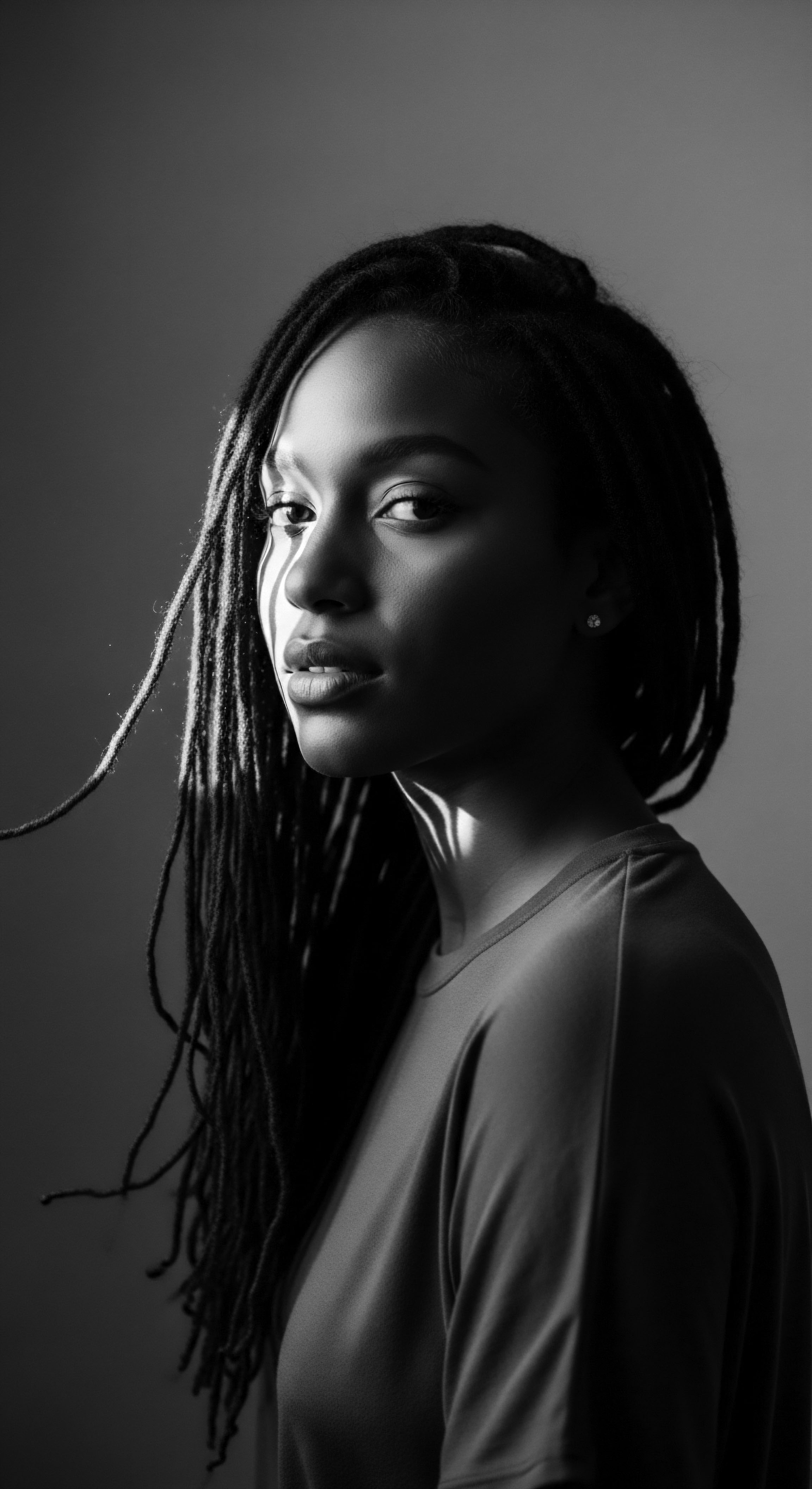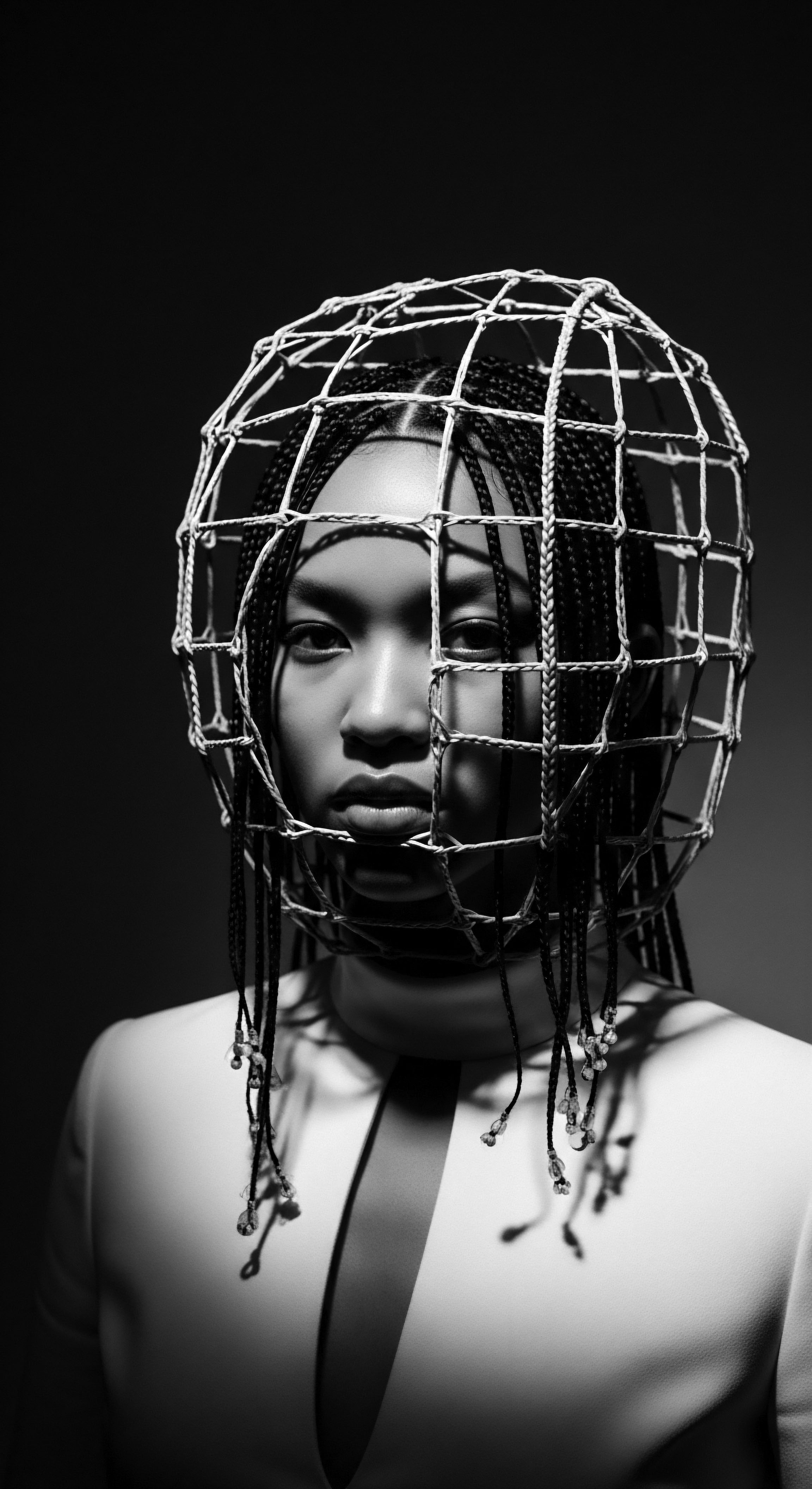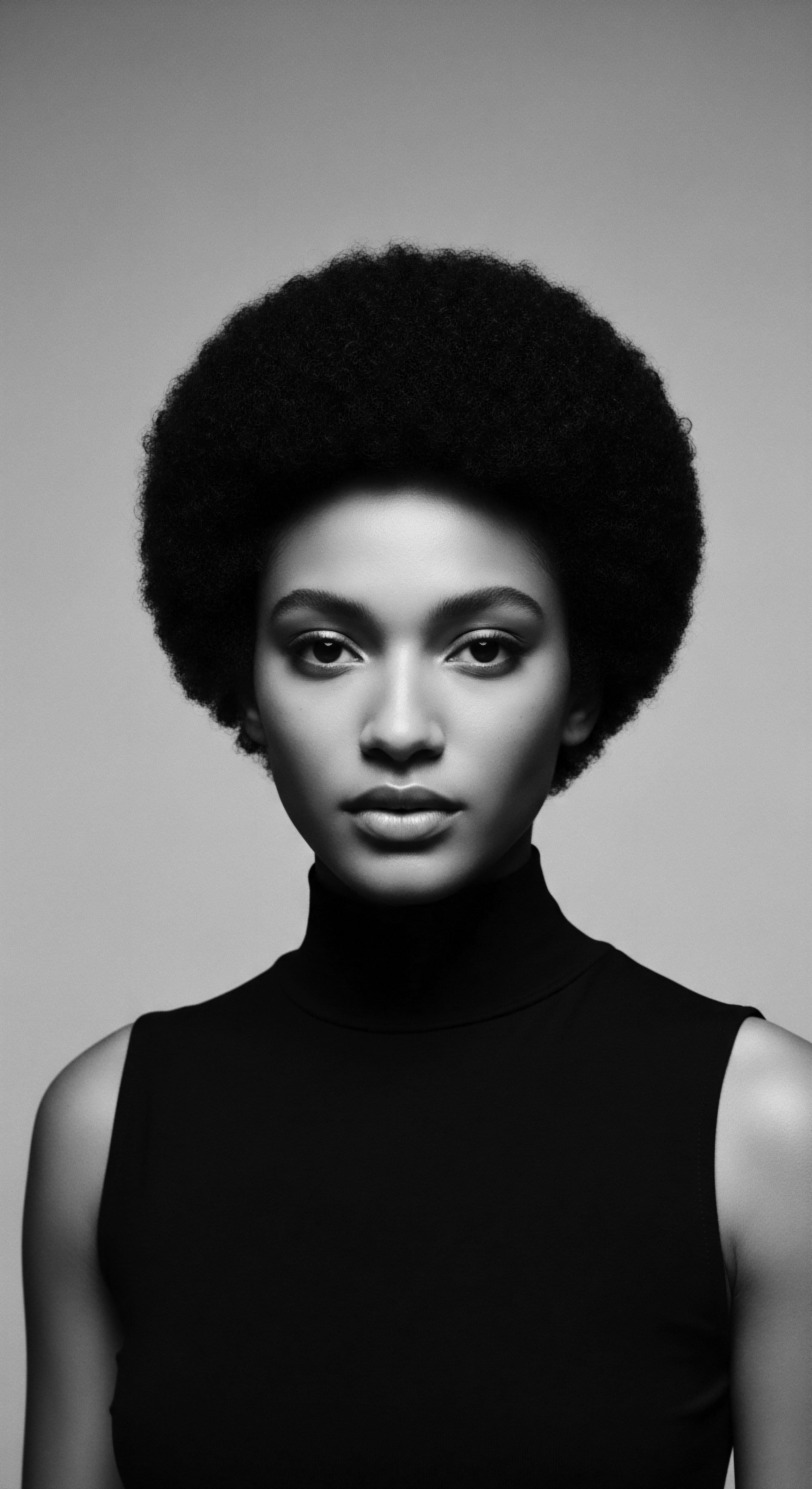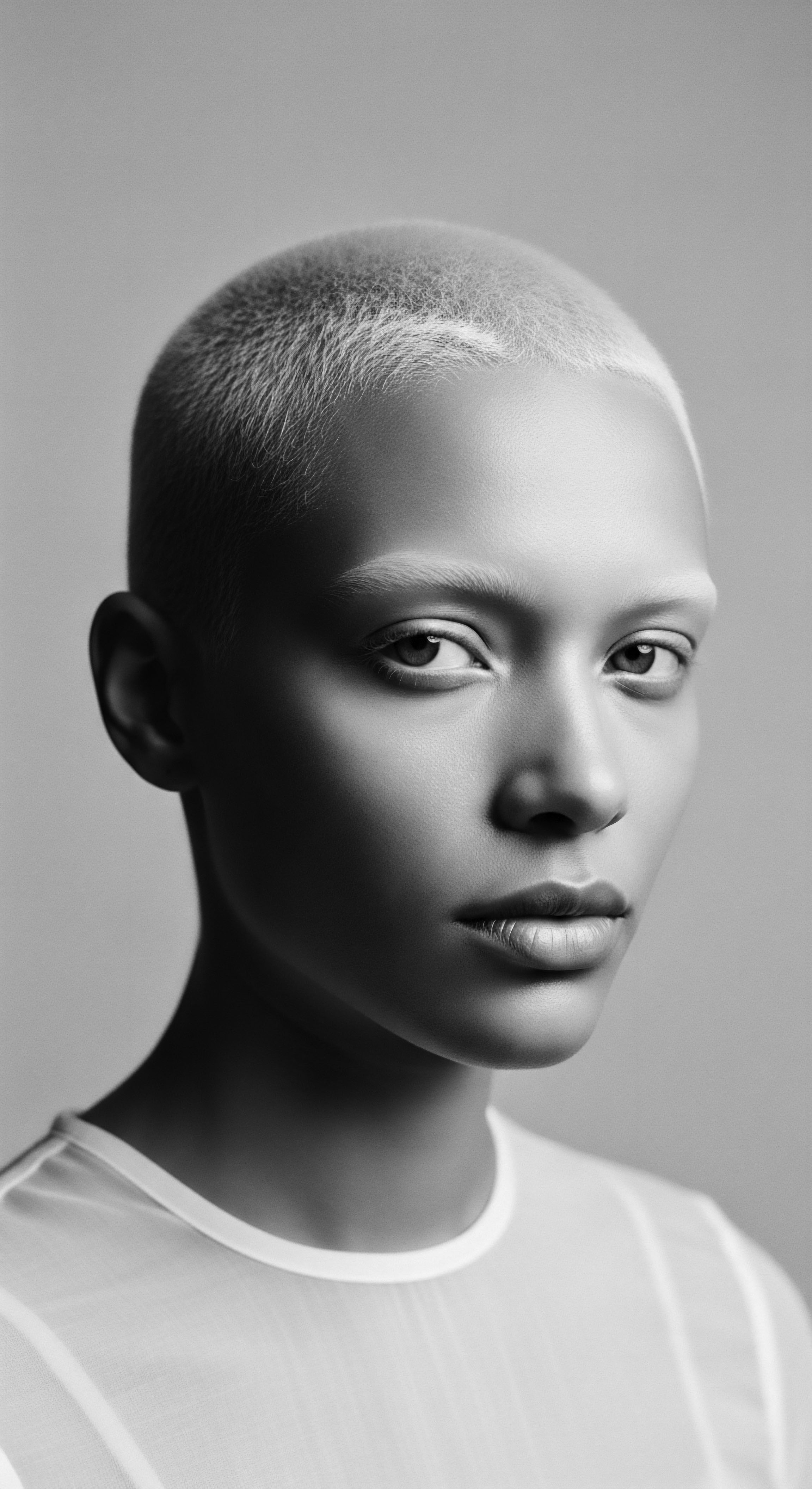
Roots
The night, a time for rest and renewal, holds a particular challenge for textured hair. For many, the quiet hours between sunset and sunrise can feel like a silent battle, a struggle against tangles, dryness, and breakage that seems to arrive with the dawn. This vulnerability, a consistent whisper across generations, finds its source in the inherent biological architecture of textured hair, a design shaped over millennia. To truly grasp why our strands stand so exposed in slumber, we must first honor the deep heritage that has long sought to understand and mitigate these very elemental truths.
Consider the individual strand of textured hair. Its journey from the scalp is rarely a straight line; rather, it is a symphony of curls, coils, and zig-zags. This unique morphology, a hallmark of Black and mixed-race hair, arises from an elliptical hair follicle. Unlike the round follicles that produce straight hair, the elliptical shape causes the keratin proteins within the hair shaft to be distributed unevenly.
This creates points of natural weakness along the curve of each coil. Each turn, each bend in the strand, is a potential site for fragility, a predisposition to damage that straight hair simply does not possess. When the hair cuticle, the outermost protective layer likened to overlapping roof shingles, is healthy and smooth, it shields the inner cortex. However, due to the tight coiling and uneven thickness, the cuticle layers of textured hair are more prone to lifting, leaving the inner structure susceptible to the elements.
This innate biological structure means textured hair requires a specific level of care, a truth recognized by ancestors long before modern scientific terms existed. The wisdom of pre-colonial African societies, for example, instinctively understood the need for hair preservation. Accounts describe intricate hair styling rituals that lasted hours, sometimes days, involving washing, combing, oiling, and specialized braiding or twisting. These were not simply aesthetic choices; they were acts of survival, methods of protecting hair that was understood to be delicate and prone to wear.
These practices, passed down through oral traditions and communal gatherings, speak to an ancient awareness of what we now identify as mechanical stress and moisture loss. The knowledge, a quiet inheritance, guided routines designed to maintain health and prevent damage, particularly during periods of rest.
Textured hair’s unique helical structure and uneven keratin distribution create intrinsic points of vulnerability to environmental stressors, especially at night.

Hair Anatomy and Its Ancestral Echoes
The architecture of textured hair is a testament to its adaptive history. The elliptical follicle and its consequent helical growth pattern result in strands that are less uniform in diameter and more susceptible to breakage at their curves. Moreover, textured hair often exhibits higher porosity , meaning its cuticle layers are more inclined to lift, allowing moisture to escape readily. This characteristic, inherent to many Black hair types, makes it naturally drier than straight hair.
The scalp’s natural oils, sebum, find it challenging to travel down the winding paths of curls and coils to adequately coat and moisturize the entire strand. This biological reality, a predisposition to dryness, has been a driving force behind ancestral hair care, long before chemical compositions of hair were understood. Our foremothers observed the dryness, the tangling, the susceptibility to breakage, and responded with practices that intuitively compensated for these structural nuances.

Cultural Lexicon of Hair Care
In many African cultures, the language surrounding hair was rich with meaning, reflecting an acute awareness of its fragility and significance. Terms for different hair textures, conditions, and protective methods existed, often integrated with spiritual or social meanings. While specific ancient terms for “nighttime vulnerability” are not readily available in transcribed historical texts, the practices themselves spoke volumes.
The emphasis on oiling, sealing, and covering hair before sleep points to an unstated but clear understanding of the environmental impact on hair. The concept of hair being a “burden” or “difficult” if not properly cared for also subtly acknowledges its delicate nature.
The wisdom of ancestral hair care, passed through generations, offers vital lessons. For instance, the Yoruba people of Nigeria, as early as the 15th century, considered hair as important as the head itself, believing its care brought good fortune. Their practice of “Irun Kiko,” African hair threading, involved using flexible threads to tie and wrap sections of hair into corkscrew patterns.
This method served not only as a style but also a protective measure, preserving the hair’s condition and reducing tangles. Such practices, refined over centuries, demonstrate a profound, inherited understanding of textured hair’s needs, anticipating the very biological challenges we now discuss with scientific precision.

Ritual
The understanding of textured hair’s vulnerability at night did not reside solely in abstract biological knowledge; it was woven into the very fabric of daily ritual. The careful preparation of hair before rest, the styling choices that offered protection, and the tools employed were all manifestations of an inherited wisdom, a deep-seated recognition that sleep, while essential for the body, could be taxing on the hair. These traditions, spanning continents and centuries, speak to a collective ancestral response to the inherent fragility of coiled strands.
Protective styling, in its myriad forms, stands as a cornerstone of this heritage. Styles like braids, twists, and cornrows, which trace their origins back thousands of years in African societies, served multiple purposes beyond adornment. They were expressions of identity, social status, and marital standing. Crucially, they were also pragmatic solutions for hair health, minimizing manipulation and shielding the hair from environmental damage.
Preparing the hair in such styles before sleep reduced the mechanical friction that could otherwise cause breakage and tangling. This historical evidence supports the idea that these methods were, in part, a response to the very biological vulnerabilities that become amplified during the hours of rest.
Ancestral protective styling rituals served as an intuitive defense against the biological fragilities of textured hair during sleep.

Protective Styling Traditions Across Time
The practice of securing hair before sleep is not a modern innovation; its roots stretch back to ancient times. Consider the Bantu knots , which originated among the Zulu people of South Africa. These coiling patterns, worn for both daily life and sleep, protected the hair from exposure and friction. Or the intricate cornrows , dating back to 3000 BC, used to express tribal identity, age, marital status, and social class.
Beyond their visual statements, these styles provided a compact, contained form for the hair, reducing its exposure to external forces, including the rubbing against sleeping surfaces. The very act of sectioning and twisting hair into these defined patterns minimized the disarray and friction that would otherwise occur with tossing and turning during the night.
- Cornrows ❉ Ancient braided patterns, serving as both cultural markers and protective styles, keeping hair secured and reducing friction during activity and rest.
- Bantu Knots ❉ Coiled hair sections, originating from the Zulu people, used for defining curls and protecting strands, particularly overnight.
- African Hair Threading (Irun Kiko) ❉ A West African technique using flexible threads to wrap hair sections, offering protection and maintaining hair health.
The cultural significance of these practices is undeniable. They were not merely cosmetic; they were deeply integrated into daily life and communal bonding. In many African homes, the act of braiding or twisting hair was a social occasion, a moment for storytelling and shared wisdom. The careful preparation of hair for the night was part of this larger system of care, a testament to the community’s collective understanding of hair as a sacred part of self.

Tools and Transformations Across Continents
The tools employed in these rituals were often crafted from natural materials, attuned to the hair’s delicate nature. Wide-tooth combs carved from wood or bone, or simply fingers, were favored for detangling, minimizing the stress that fine-toothed combs might impart. The use of natural fibers for tying or wrapping hair further illustrates this gentle approach.
The evolution of head coverings , particularly bonnets and wraps, provides a clear historical link to this nighttime vulnerability. While bonnets found early uses in European societies for warmth, their adoption and adaptation within Black communities, especially during and after enslavement, took on profound significance. Headwraps, known as dukus in Ghana and doek in Namibia, were traditional attire in African regions, indicating wealth, ethnicity, or marital status.
During enslavement, these coverings were, for a time, weaponized, used to mark Black women as “lesser.” Yet, in a powerful act of resistance and reclamation, Black women transformed them into symbols of creative and cultural expression, using vibrant fabrics and intricate adornments. More profoundly, they became essential tools for preserving hair, protecting it from harsh conditions and minimizing damage while sleeping.
| Traditional Practice Protective Hairstyles (braids, twists) |
| Underlying Biological Benefit Reduces mechanical stress and friction on individual strands during sleep. Minimizes tangling. |
| Traditional Practice Headwraps/Bonnets (silk, satin) |
| Underlying Biological Benefit Creates a smooth barrier against rough sleeping surfaces, preventing moisture absorption and friction. |
| Traditional Practice Natural Oils and Butters (shea, coconut) |
| Underlying Biological Benefit Replenishes moisture, seals the cuticle, and lubricates the hair shaft, mitigating nighttime dryness. |
| Traditional Practice These historical solutions directly addressed the biological challenges of textured hair, showcasing enduring ancestral wisdom. |
This historical connection is not merely anecdotal; it speaks to generations of empirical observation. The women who wrapped their hair at night knew, perhaps not in scientific terms, that it awoke more manageable, less tangled, and better preserved. The transformative power of these rituals was a lived experience, deeply ingrained in the heritage of textured hair care.

Relay
The legacy of understanding textured hair’s nocturnal vulnerability, once held in ancestral practices and communal wisdom, now finds resonance in modern scientific inquiry. The insights passed down through generations, often embodied in simple, yet profound, rituals, are affirmed by contemporary trichology and material science. The biological reasons for textured hair’s particular susceptibility at night are multi-layered, extending beyond mere observation into the intricate mechanics of the hair shaft itself, all informed by the enduring heritage of those who learned to care for it.
At its core, the vulnerability of textured hair at night stems from two primary biological adversaries ❉ mechanical friction and moisture loss . As an individual sleeps, the inevitable tossing and turning creates constant rubbing between the hair and the sleeping surface. For textured hair, with its unique, often irregular, cuticle layer and numerous points of curvature along the strand, this friction is particularly damaging. Unlike straight hair, where the cuticle scales lie flat, textured hair often has more raised cuticles due to its coiled shape.
This creates a rougher surface that catches and snags on absorbent, fibrous materials like cotton pillowcases. Each snag can lift, chip, or even remove cuticle cells, leaving the inner cortex exposed. This progressive damage weakens the hair shaft, making it brittle and highly prone to breakage and split ends.
Compounding this mechanical stress is the challenge of moisture retention. Textured hair is often naturally drier than other hair types because its coiled shape impedes the even distribution of the scalp’s natural oils down the hair shaft. During the night, especially in dry environments or on absorbent pillowcases, moisture readily evaporates from the hair. Cotton, a common pillowcase material, is highly absorbent and actively draws moisture away from the hair.
This dehydration renders the hair even more brittle and susceptible to breakage from friction. The combination of structural fragility, constant friction, and inherent moisture depletion creates a perfect storm for damage during sleep.
The dual forces of friction and moisture evaporation, amplified by textured hair’s coiled structure and elevated cuticles, predispose it to significant damage during sleep.

How Does Sleeping Surface Material Affect Hair Integrity?
The choice of sleeping surface is a critical, yet often overlooked, factor in nightly hair health. The rough, absorbent fibers of common cotton pillowcases act as microscopic abrasive agents, exacerbating the friction on textured hair. This constant rubbing roughs up the hair’s cuticle, leading to a dull appearance, frizz, and ultimately, breakage.
Contrast this with the smooth, tightly woven fibers of silk or satin . These materials create significantly less friction, allowing the hair to glide across the surface rather than snagging. A study published in the Textile Research Journal indicated that high-quality silk withstands more mechanical stress than regular cotton, maintaining its structure and softness.
Moreover, silk and satin are far less absorbent than cotton, meaning they do not strip the hair of its vital moisture and applied products overnight. This dual benefit of reduced friction and moisture retention makes them superior choices for protecting textured hair during sleep.
This scientific validation of silk and satin echoes a practical wisdom long understood within textured hair communities. The widespread adoption of satin bonnets and headscarves among Black women, for instance, serves as a powerful historical example of this intuitive scientific understanding. Bonnets have been a staple in textured hair care since at least the 1950s, used as a protective style for sleeping to maintain texture and style, and to guard against friction and moisture loss. Their roots, though debated in precise origin, connect to traditional African headwraps that served similar protective and symbolic roles for centuries.

What Ancestral Practices Mitigated Nighttime Damage?
Ancestral practices intuitively addressed the biological vulnerabilities of textured hair at night, long before the scientific lexicon for cuticle integrity or transepidermal water loss existed. Communities across Africa and the diaspora cultivated routines that acted as a shield for their hair.
- Oiling and Conditioning Rituals ❉ The widespread use of natural oils and butters, such as Shea Butter and coconut oil, provided a protective layer to the hair. Shea butter, derived from the Vitellaria paradoxa tree in West Africa, has been used for centuries to protect skin from harsh sun and wind, and to nourish and moisturize hair. These emollients helped seal the hair’s cuticle, reducing moisture evaporation and providing lubrication against friction. Ancient Egyptians, including figures like Cleopatra and Queen Nefertiti, are reported to have used shea butter for both skin and hair care, understanding its protective properties.
- Protective Styling Before Sleep ❉ As discussed, braiding, twisting, and coiling hair into compact styles significantly reduced the surface area exposed to friction. This practice maintained curl definition and prevented extensive tangling, thereby minimizing breakage upon waking. The careful preparation of hair for the night was a common practice, safeguarding the day’s styling efforts and preserving hair health.
- Head Coverings ❉ The use of headwraps, bonnets, and sleep caps was a direct response to environmental stressors. These coverings provided a physical barrier between delicate hair and rough sleeping surfaces, retaining moisture and reducing friction. The transition from culturally symbolic headwraps to dedicated sleep bonnets in African American communities highlights an enduring commitment to hair preservation. These coverings acted as a micro-environment, stabilizing humidity around the hair and preventing excessive drying.
A notable study on the efficacy of silk pillowcases aligns with this ancestral wisdom. Research published in the Journal of Dermatological Science indicated that silk pillowcases reduce transepidermal water loss (TEWL), helping to regulate skin moisture. While this study focused on skin, the principle extends to hair, as hair also loses moisture to its environment. This scientific finding provides a contemporary lens through which to appreciate the protective benefits of smooth head coverings and hydrated environments, practices that African and diasporic communities intuitively embraced for centuries.
The wisdom embedded in these ancestral care rituals speaks volumes. They represent a collective body of knowledge, refined over countless generations, demonstrating an innate understanding of textured hair’s biological nuances. The modern scientific explanations of cuticle integrity, keratin distribution, and friction’s impact on the hair shaft serve not to invalidate this heritage, but to illuminate its profound foresight. The biological reasons for textured hair’s vulnerability at night were known, in their own terms, to those who lived this heritage, guiding the creation of sophisticated, protective rituals that remain relevant today.

Reflection
As the soft light of dawn touches the window, dispelling the night’s quiet, we recognize that the enduring strength and resilience of textured hair lie not only in its remarkable biological structure but equally in the rich heritage of care that cradles it. The vulnerability textured hair experiences in sleep, rooted in its unique helical form and propensity for moisture loss and friction, has never been a secret to those who have lived its reality. Instead, it has been a catalyst for ingenuity, a whisper from the strands themselves that called forth a legacy of wisdom.
The profound meditations on textured hair, its heritage, and its care become a living, breathing archive, a testament to the ancestral knowledge that recognized fragility and responded with reverence. From the careful plaits that mimicked the protective coils of nature, to the comforting embrace of the bonnet, a symbol reclaimed and cherished, each practice speaks of a journey into deep understanding. It is a journey that connects the biological truths of the hair shaft to the cultural practices that transcended generations, linking ancient African rituals to contemporary routines.
In every strand lies a story—a story of biological uniqueness, yes, but more significantly, a story of an ancestral journey through ingenuity and resilience. The knowledge passed down, often wordlessly, through hands that braided and oiled, has safeguarded this heritage. It is a continuum of care, a luminous thread connecting us to those who came before, reminding us that truly understanding textured hair means honoring its profound past and preparing it for a vibrant future.

References
- Byrdie. (2022, September 27). The Significance and History of Bonnets.
- Annie International, Inc. (2023, December 21). The Origin Story Of The Bonnet.
- I Love Riccio. How not to damage curly hair at night.
- Kera Mane. (2025, February 6). Keratin Treatments for Ethnic and Textured Hair ❉ Key Considerations.
- SEAMS Beauty. (2018, January 8). The History Of Shea Butter.
- Croda Beauty. (2025, March 26). Advancing the future of textured hair solutions.
- Helix Hair Labs. (2023, March 3). THE HISTORY OF THE HAIR BONNET.
- Redken. The Science of Curly Hair.
- Pattern Beauty. (2022, February 7). Sleeping With Curly Hair ❉ 7 Tips For Preserving Curls Overnight.
- Hype Hair. (2023, June 26). Unveiling the History of the Hair Bonnet for Black Women.
- Obscure Histories. (2024, February 13). Ancient Gems ❉ A Historical Survey of African Beauty Techniques.
- BLAM UK CIC. (2022, September 15). The history of Black Hair.
- Ciafe. (2023, January 31). Shea Butter.
- fit cosmeticos. (2017, October 2). Understanding the structure and fragility of curly hairs.
- Anna Mitchell Trichology Clinic. (2024, March 4). Hair Structure.
- Quora. (2024, July 30). Why did my hair texture change overnight like it feels brittle and dry out of nowhere?
- Mukhaye. (2024, August 11). Hair Cuticle Care ❉ The Complete Guide to Protecting and Strengthening Your Hair.
- Karitédiema. (2025, April 2). The Shea Tree ❉ A Treasure of Africa.
- Fashionista. (2024, March 27). How to Protect Curly and Coily Hair Overnight, According to Experts.
- Birico. (2025, April 15). Silk vs Cotton ❉ Which Pillowcase Is Better for Your Skin and Hair?
- Rush Hair & Beauty. How To Protect Your Hair While Sleeping.
- Gisou. (2023, March 22). 10 Simple Tricks to Keep Your Hair From Getting Frizzy Overnight.
- Solsilk. (2024, April 11). The Science Behind Silk.
- ResearchGate. Human Hair Keratin Network and Curvature.
- GirlsOnTops. (2020, August 31). A Sacred Legacy ❉ On Black Hair And The Revolutionary Power of Self-Expression.
